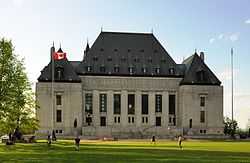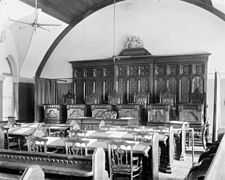History of the Supreme Court of Canada
of Canada |
|---|
 |
| Current members |
| All members |
| Judgments |
The history of the Supreme Court of Canada can be divided into three eras. Initially, from the court's inception in 1875 to 1949, it remained largely reserved and conservative. Its decisions could be appealed Judicial Committee of the British Privy Council, and it was often overturned on major issues.
The second era spanned from the abolition of appeals to the Privy Council in 1949 until the introduction of the Canadian Charter of Rights and Freedoms in 1982. This period consisted of a gradual legitimization of the Supreme Court as the supreme judicial body in the country, and a liberalization of much of its jurisprudence. The adoption of the Charter proved to be a dramatic change in the role of the court in Canadian society. Under the Charter, the court moved aggressively into many areas of laws, creating broad protection of civil liberties, aboriginal rights, and equality rights.
Origins
With the formation of the Dominion of Canada in 1867 there was a growing movement to create a final court of appeal for the new country. John A. Macdonald, along with Télésphore Fournier, Alexander Mackenzie, and Edward Blake, championed the creation of a Supreme Court. However, those strongly loyal to the English tradition opposed it and managed to get bills withdrawn in both 1869 and 1870. Additionally, there was resistance from Quebec until the Guibord case demonstrated to them that Privy Council rulings could not always be sensitive to their religious culture. It was not until April 8, 1875, that the bill was finally passed.
Initially, there were only six judges on the Supreme Court. This eventually resulted in several even split decisions, and it was eventually increased to seven in 1927. In 1949, with the abolition of appeals to the Judicial Committee of the Privy Council, the complement of judges was increased again to nine.

The court was inaugurated on November 18, 1875. Initially they sat in the Railway Committee Room inside the Parliament buildings. They moved around among several vacant rooms until 1882 when they were relocated to a newly renovated building at the entrance of Parliament that had been used as a carriage house. It was only in 1949 that they were relocated to the courthouse where they preside today.
The court's first sitting was on January 17, but since there were no cases to be heard they adjourned until spring. That April the court was given a reference question from the Canadian Senate (in Re "The Brothers of the Christian Schools in Canada"). The Senate wanted to know if a bill entitled "An Act to incorporate the Brothers of the Christian Schools in Canada" was constitutional and within the authority of the federal government. Only Ritchie, Strong, and Fournier JJ. were in attendance, each only giving a short judgement. It was not until June that the Court heard its first case with Kelly v. Sulivan.
Under the Privy Council
In the early days all cases could be appealed from the Supreme Court of Canada to the Judicial Committee of the Privy Council in London. As well, cases could bypass the Supreme Court and go directly to London from the provincial courts of appeal. The decisions of the Supreme Court on the interpretation of the Constitution tended to support the popular view that it was intended to create a powerful central government. The Privy Council, however, held a distinctly opposite view of the Constitution as providing for strong provincial powers . The decisions of Lords Haldane and Watson strongly reflected this view in their decisions which became increasingly unpopular. In many of their decisions they interpreted the Trade and Commerce power as well as the peace, order and good government power of the federal government to be exceptionally limited. Many of these decisions had the result of striking down a number of reforms proposed by both the Conservative Government of R. B. Bennett and the following Liberal government of MacKenzie King, despite public support. Consequently, provincial governments began to demand the federal government press the United Kingdom for judicial independence. The Supreme Court of Canada formally became the court of last resort for criminal appeals in 1933 and for all other appeals in 1949. The last Canadian case heard by the Privy Council was in 1959, as the case had been grandfathered.
Laskin Court
The appointment of Bora Laskin as Chief Justice in 1973 represented a major turning point for the Supreme Court. Many of the Laskin Court justices were either academics or well-respected practitioners, most had several years experience in appellate courts. Laskin's federalist and liberal views were an influence in many of the court's decisions. The change in direction of the court proved somewhat controversial. Laskin's style was abrasive enough that it provoked Justice Louis-Philippe de Grandpré to take early retirement. His promotion to Chief Justice also upset Ronald Martland who by convention, expected to be appointed to the position since he was the most senior puisne justice at the time.
Among the most notable cases to go through the court in this period included Calder v. British Columbia (Attorney General) [1973] S.C.R. 313 where the court acknowledged the existence of a free-standing aboriginal right to land. In R. v. City of Sault Ste-Marie [1978] 2 S.C.R. 1299 the court established the standard for strict liability offences in the criminal law. Reference re a Resolution to amend the Constitution [1981] 1 S.C.R. 753 was one of the first times the court acknowledged the existence of an unwritten constitutional convention, namely the constitutional obligation to get consent from the provinces for an amendment.
Dickson Court
The beginning of the Dickson Court corresponds to the first of the Charter cases heard by the Supreme Court.
The Dickson Court oversaw some of the most fundamental changes in Canadian jurisprudence. The court decided many foundational cases for Charter jurisprudence, including R. v. Oakes (section 1) and RWDSU v. Dolphin Delivery Ltd. (scope of the Charter). Among the most radical decisions of this period include Re B.C. Motor Vehicle Act which broke away from the conventional wisdom that due process only protected procedural rights by including substantive rights as well. This case was later followed up with the decision of R. v. Morgentaler, which proved significant both because it struck down the criminalization of abortion but also because of its expansion of due process rights into the civil context.
The Dickson Court era also saw the beginning of a major shift in Canadian administrative law, with the "pragmatic and functional approach" appearing in U.E.S., Local 298 v. Bibeault.
The last years of the Dickson Court saw an entire revision of the area of conflict of laws by Justice Gerard La Forest in the decisions of Morguard Investments Ltd. v. De Savoye [1990] 3 S.C.R. 1077. This would continue in the Lamer Court era with subsequent decisions such as Hunt v. T&N plc, [1993] 4 S.C.R. 289 and Tolofson v. Jensen.
Lamer Court
Antonio Lamer's criminal law background proved an influence on the number of criminal cases heard by the court during his time as Chief Justice.
McLachlin Court
The appointment of Beverly McLachlin as Chief Justice has resulted in a more centrist and unified court. Dissenting and concurring reasons are fewer than during the Dickson and Lamer Courts. The court has also seen some of the lowest numbers of decisions released in a year. In 2006, only 59 judgments were released, the smallest number in 25 years.
See also
References
- McCormick, Peter (2000), Supreme at last: the evolution of the Supreme Court of Canada, J. Lorimer, ISBN 1-55028-693-5
- Ostberg, Cynthia L; Matthew E. Wetstein (2007), Attitudinal decision making in the Supreme Court of Canada, UBC Press, ISBN 978-0-7748-1312-9
- Songer, Donald R (2008), The transformation of the Supreme Court of Canada: an empirical examination, University of Toronto Press, ISBN 978-0-8020-9689-0
External links
- origins of the SCC
- history of the Duff Court
- Charter trends of the Supreme Court of Canada
- statistics from 1998 to 2008
| ||||||||||||||||||||||
| ||||||||||||||||||||||||||||||||||||||||||||||||||||||||||||||||||||||||||